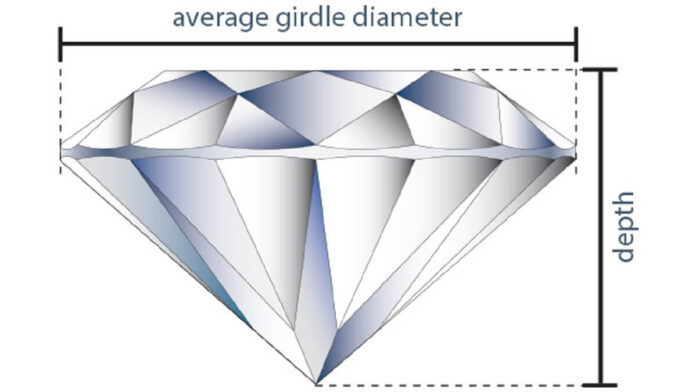A typical round-cut diamond has various parts, including the girdle, table, crown, pavilion, and culet. Jewelers use various terms to describe a diamond’s anatomy. Pavilion refers to the lower part of the V shape in the diamond. The pavilion acts as a mirror that reflects light to the top crown and table and back to the viewer. Pavilion depth is the distance from the girdle’s bottom edge to the cone’s lowest point.
Impact of Pavilion Depth
The pavilion depth is expressed as a percentage of the girdle diameter. The pavilion depth percentage is calculated by dividing the pavilion depth by the girdle diameter and multiplying the result by 100%. If the pavilion depth is too deep, it won’t reflect the entering light properly. Some of the light may escape away from the first facet.
Read Also: Stunning Winter Dresses Collection for Ladies
If the pavilion depth is too shallow, the pavilion may reflect light off the opposite crown facet. Ideal pavilion depth allows the light to bounce across the second pavilion facet. The entering light shouldn’t go away from the opposite pavilion facet. It should return to the observer through the table. Pavilion depth contributes to the fire and brilliance of the diamond.
Jewelers can also use depth to increase the size of a modest diamond’s appearance. A shallow depth may make the diamond appear larger when you view it from above. The pavilion depth shouldn’t be too shallow because the diamond may appear dull and muted. Most people judge the pavilion depth visually, but you can also measure and calculate it.
The Ideal Pavilion Depth Percentage
The pavilion reflects light to the table, so when you look into a diamond, you see a gray octagon. If the pavilion depth is optimal, you’ll see a perfect reflection of the table in the pavilion. The ideal pavilion depth percentage range can create the most beautiful diamonds. Shallow pavilion depth can make the reflection pattern appear smaller and fragmented.
A small, fragmented pattern may give your diamond a rough look. The pavilion depth percentage also affects the girdle reflection, which may appear as an unattractive gray ring around the table facet. The fish-eye effect is common in stones with shallow pavilions and large tables. Fish eyes can make your diamonds appear dull and faded.
If the pavilion depth percentage is deeper than ideal, your stone will look darker. Overly deep pavilion depths can make the entire table of the diamond dark, resulting in the nail-head effect. Nail heads and fish eyes are properties of poorly cut diamonds.
Pavilion Depth and Angle in Different Cuts
Diamonds come in unique cuts, including round, princess, Asscher, cushion, marquise, radiant, pear, heart, emerald, old European, and square radiant. The ideal percentages above are for round-cut diamonds. Other cuts have unique features and ideal dimensions. Some jewelry designers use pavilion angle instead of depth when evaluating diamond promotions.
The pavilion angle and depth are different but assess the same aspect. A steeper angle will create a greater depth percentage. Pavilion angles are responsible for the sparkling, eye-catching appearance of diamonds. The angle reflects light outwards after refracting it from one side of the diamond to the other. An ideal pavilion angle will create a beautiful light prism.
Working With Leading Diamond Jewelers
Diamonds with shallow or deep pavilion depth will struggle to show their full beauty. You need experienced jewelers to help you achieve the ideal proportions. Choose reputable jewelry designers that provide excellent diamond cuts with the ideal pavilion depth and angle. Stick to long-serving companies with a clean track record of delivering premium gems and cuts. Find the perfect diamond for you or a loved one with the help of a reliable jeweler.





